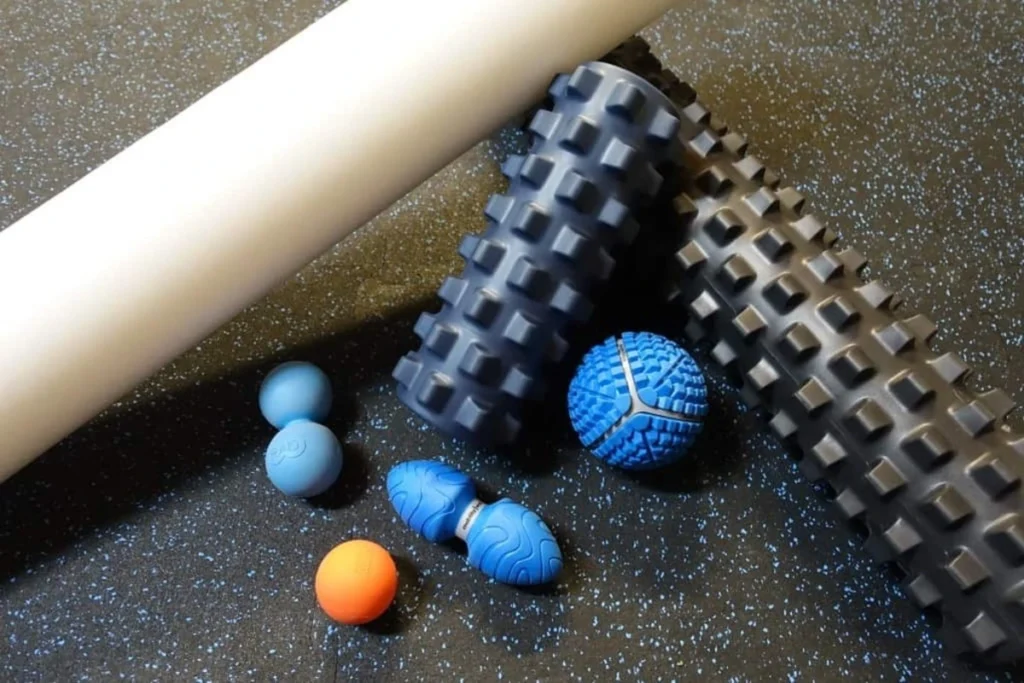If you are someone who likes to stay active and enjoys working out, then you know that muscle injuries can be a real pain. Not only do they take time to heal, but they can also keep you from doing the things you love.

The best way to avoid injuries is knowing your body, warming up, mobility work, and doing some post-exercise stretching. Even then, though, sometimes injuries are unavoidable. So once you are injured, you need to know what to do next.
There are many types of injuries but muscle injuries – specifically muscle strains– are the most common and can range from mild to severe. Some strains are short-term, while others – such as a torn muscle – can take several months to heal. And always remember that it is important to see a doctor if you’ve been experiencing persistent or severe pain, numbness, or tingling after injuring one or more of your muscles.
To help make things easier for you, here are ideas on how to return to training following muscle injuries. Follow our tips and you’ll be on your way to recovering quickly and getting back into the gym!
Mark Your Calendar
Of course, different types of muscle injuries will require different timeframes for recovery. For example, a torn muscle will take longer to recover than a simple muscle strain. But it is important to follow several simple guidelines once you feel ready to start training again.
If you’ve been sidelined by your muscle injury for several weeks, it is a good idea to plan to return to where you were before getting injured after taking several weeks to a month of rest. But it will take much longer for you to return to your peak performance if you’ve suffered a more debilitating injury that will require a month or more of rest and physical therapy.
Regardless of what kind of muscle damage you’ve suffered, it is important to start slow and simple and aim for making manageable increases over time. Do not put any extra stress on your body.

To that end, make sure you understand the difference between pain and discomfort. Muscle discomfort is okay to work through, muscle pain is not. As a general rule, muscle discomfort stops when you stop the exercise. If it continues, you’ve gone too far.
If you push yourself too hard, you will run the risk of aggravating your injury. If this happens, you’ll have to plan for more downtime. So once you’ve determined that you don’t have pain, you can now use your soreness level as a general test.
If you do not have muscle soreness at the end of a workout – or in the following day – it might be a good time to increase the intensity of your next training session. On the other hand, make sure to cut back on your workouts or the intensity of the workout if you are feeling sore.
Take time to celebrate every small victory. You will also need to have plenty of patience as it will take some time before you’ll be able to return to your peak. If you feel like taking a rest, then do it.
Just remember, there are many ways to get some physical activity when injured. Anything from walk to using resistance bands to lifting weights are good options, so long as you listen to your body and work smart.
Take a Step Back To Go Forward
While the title of this section sounds like a bad fortune cookie, let me explain. The more time that passes when you’re not working out, the more muscle you will lose. It’s the simple “use it or lose it” concept. Not only will you lose skeletal muscle, unfortunately, your endurance will also decrease.
Now, that’s the bad news. The good news is that once you get back to regular muscle function, you’ll be able to recover those lost gains pretty quickly. So, yes, you’ve taken a step back because of the injured muscle but use this time to safely build back strength and mobility.

For example, if you were going on long runs before your recent sporting injury, you shouldn’t expect to immediately return to the same level after you recover from your injury. This is especially the case for those who have not been working out for more than several weeks. You are bound to notice a significant decline in your aerobic abilities.
Therefore, you will need to gradually build yourself up to going longer runs. One of the best ways to start doing this is by doing movements similar to you training goal. As a runner, maybe start by walking or by using a jump rope.
Exercising After Injury: Lighten Your Load
It can be extremely challenging to get back into lifting weights after an injury. You should not consider returning to the weight room until you feel ready.
If you’re a lifter, focus on doing bodyweight movements or using light weights on the affected muscle. Work on getting a full range of motion and some movement to the joint and muscle. While it’s not likely you’ll get scar tissue for most muscle strains, it is possible for more severe strains.

If that’s the case, you can also do soft tissue work. Go get a massage. Use tools such as a foam roller, a massage gun, lacrosse balls, or other implements to break up any trigger points or “knots” in your muscle.
Lastly, if needed, consider modifying the exercise to work in a reduced range of motion. For example, if you injured your lower back but still want to deadlift, consider using a trap bar but doing some from an elevated position. Coupled with the lighter weight, you’ll still be able to work out your strained muscle safely and start to rebuild some strength.
Stay With Low Intensity
Following a pulled muscle or soft tissue injuries, you will need to wait a few weeks before returning to HIIT and Crossfit-style workouts. This is because it will be necessary for you to rebuild your muscles, restore range of motion, and get endurance back up.
If you increase the intensity of your workouts too quickly, you’re more likely to reinjure yourself and have to and have to take even more time off to recuperate.

For this reason, it’s also not a good idea to join workout classes right away unless you’re prepared to take a step back from your normal intensity level. Instead, practice the exercises that you typically perform in classes on your own.
This will help you get a clearer idea of what types of workouts you are ready to participate in.
When you do join workout classes again, make sure to inform your trainer/coach that you are still in the process of recovering from a muscle injury. A good trainer will help you adapt the exercises to aid your recovery process.
Pay Attention to What You Are Doing
It is important to have a positive mindset when you are recovering from a muscle injury. While an injury is never fun, this is a good time to try and turn your weaknesses into strengths.
Unfortunately, athletes tend to focus on the negative aspect of being injured. This is why they don’t always recognize that there are other workout options that are available to them.
For example, if you have an arm injury, you can focus on lower body exercises that will not require the use of either of your arms. Sore all over? Maybe it’s a good time to work on your overall mobility and do some light preventative exercises.
No matter what, there’s almost always some way to keep improving. Try to increase strength or mobility in these body parts. And remember to go slowly.
Listen to Your Body
Like I mentioned above, there is no issue with experiencing a bit of discomfort, but you should not be experiencing pain. In fact, if you experience sharp or severe pain at any point, you should immediately stop. You can then rest up and reevaluate after the pain subsides.

By the same token, if your discomfort lasts for more than an hour after you’ve finished an exercise, chances are that you’ve pushed your body too far. Again, consider resting for several days and/or working around your injury before you return to your exercise routine.
Set the Right Goals
While goal setting can be complex, let’s make it simple: all of your workout goals should be achievable, measurable, and realistic.
It will be much more manageable for you to recover from your injury if you focus on doing aerobic five-minute intervals of aerobic activity instead of shooting for one hour. If you set ambitious goals, try to be patient.
Understand that you will need to gradually work towards achieving them. You might need to extend your timeline and be flexible. It will also be important for you to be ready to make pivots.
If your original goal was to be ready to run a marathon in three months but you are still experiencing significant pain, don’t be afraid to set a new goal. Maybe you will need to wait for six months before running a marathon.
Develop a Routine
You will recover from your injury much more safely and quickly if you create a routine. Keep in mind that different kinds of athletes will need to set up different kinds of routines but the basics apply to everyone.
In short, make a habit of working out even if you are recovering from an injured muscle. While you may not be able to work the muscle directly, you can do absolutely workout in other ways.

For example, if you’re a runner, you could focus on doing low-impact aerobic exercises such as swimming and bicycling. Again, having the proper mindset will allow you to progress and stay positive even with a strained muscle.
And, who knows, maybe you’ll find something new you’ll really enjoy.
Hire a Personal Trainer or Physical Therapist
One of the best things you can do to safely and effectively return to training following a muscle injury is to hire someone to help you out.
Physical therapists are ideal are they have a lot of experience helping people recover from muscle injuries. But don’t limit yourself to just a PT. A good coach or trainer (or maybe even a chiropractor) will also be able to help.
A skilled trainer or PT will be able to do many things:
- Evaluate your injury and give you appropriate exercises to do on your own.
- Give further guidance and recommendations on how to recover
- Track your progress
- Help you set realistic goals
- Develop a fitness routine that will get back on track
If you are not sure how to find the right trainer, it is a good idea to get recommendations from colleagues or friends or do a quick web search.
Returning to Training After Muscle Injuries
In summary, if you have been wondering how to return to training following muscle injuries, remember how important it is to be patient, listen to your body, and set realistic expectations.
While skeletal muscle injuries do suck, if you have the right attitude, it can also be a blessing in disguise. Take the time to learn, rest, and work hard to prevent future muscle strains.
If you are looking for the right kinds of products to help you recover after a sports injury, make sure to check out our product reviews.







